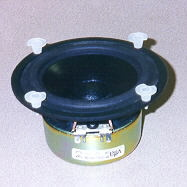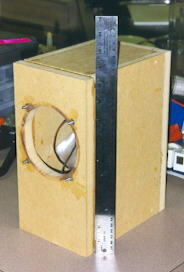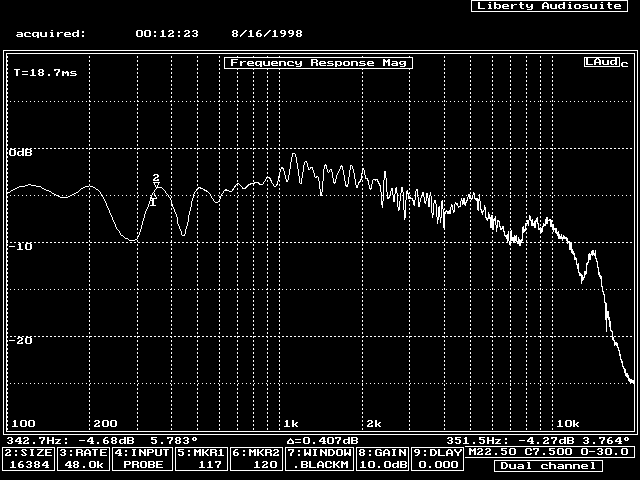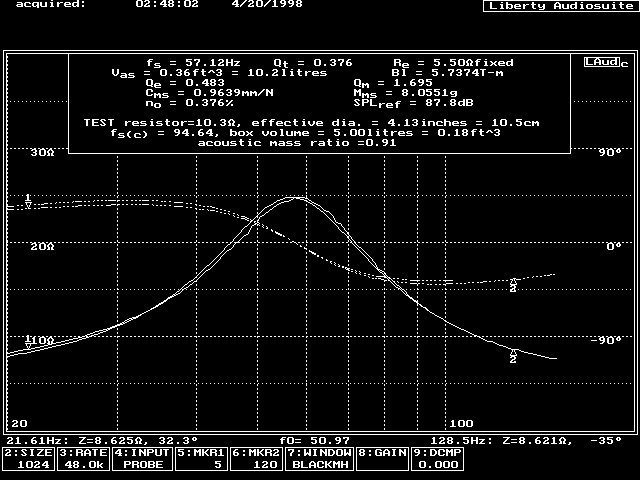These are the results of my March 1998 search. Scan-Speak and Peerless are absent; no shielded drivers are available. Dynaudio and Morel place the magnet inside of the driver basket. That placement gives a tight magnet field that is close to, but I don’t believe as good as, bucking magnet shielding. Eton makes a 4″ shielded mid (at $98), but nothing larger.
Seas also makes some shielded co-axial drivers; a mid-range with the tweeter located
where the dustcap is normally found. The mid’s cone acts as a horn on the tweeter and modulates the tweeter’s output via the mid’s cone motion. The latter is a non-linear distortion. Why then would anyone use a co-axial driver? The big reason is the co-location of the mid-range and the tweeter. The time delay between them is minimized, and almost invariant with changes in the listening axis. The modulation distortion is minimized by limiting the mid-bass and bass content sent to the mid. A 400 Hz cross-over to another mid-range or mid-bass unit has been commercial used to accomplish this task. Since the project goal is an MTM, not an WTMW (W for woofer), no co-axials were considered.
| Param | Vifa | Vifa | Vifa | Focal | Seas | Seas |
|---|---|---|---|---|---|---|
| Model | M17SG-09 | P17SJ-00 | ??? | 5N411LB | P14RC/TV (H626) | P17RE/TV (H690) |
| Price [1998] | $33.50 | $34.90 | $46.70 | $84.50 | $42.20 | $52.50 |
| Size | 5″ | 6.5″ | 6.5″ | 5″ | 5″ | 6.5″ |
| Material | Paper | Paper | Poly | Neoflex | Poly | Poly |
| Fs [Hz] | 54 | 34 | 41 | 45 | 40 | 34 |
| Qts | 0.35 | 0.34 | 0.35 | 0.35 | 0.21 | 0.27 |
| Efficiency [dB/2.83v] | 88 | 89 | 87 | 87.5 | 89.5 | 88.5 |
| Vas [l] | 12 | 53 | 33 | 14 | 18.9 | 30.5 |
| Xmax [mm] | 2 | 3 | 4 | 3.25 | 3 | 3 |
| Power [w] | 35 | 50 | 70 | 60 | 60 | 80 |
These prices were “current” of 03/31/98 from Madisound. Xmax ratings are peak one way.
The Vifa D27SG-05 does not have “tinsel leads” or a similar technology. I interpret this to mean a crossover frequency below 3 kHz is not likely to lead to long term tweeter reliability. A crossover frequency above 3kHz limits the mid-range selection to 5″ or smaller drivers.
This is not a cost-is-no-object design, which yields the Vifa M13SG-09 and Seas P14RC/TV as the two best candidates. The P14RC/TV manufacturer response curves shows some response anomylies in the 1-2 kHz region where the human ear is most sensitive. My conclusion: get the Vifa M13SG-09.
The measurements of the Vifa M13SG-09 were good enough that no other units have been examined.
Vifa M13SG-09
The LAud results of mid-range B tested for its Thiele-Small parameters.
The table below summarizes the Thiele-Small testing I have done so far on the dozen mid-ranges that I ordered. (Yep, a dozen!) The results are before any break-in of the suspensions. The test signal level was -30 dB.
| Spec | A | B | C | D | E | F | G | H | I | J | K | I | |
|---|---|---|---|---|---|---|---|---|---|---|---|---|---|
| Re [ohm] | 5.6 | 5.6 | 5.5 | 5.6 | 5.45 | 5.5 | 5.6 | 5.5 | 5.5 | 5.6 | 5.6 | 5.6 | 5.6 |
| fs [Hz] | 54 | 54.45 | 57.71 | 57.25 | 55.31 | 56.63 | 57.96 | 56.19 | 54.22 | 52.87 | 53.82 | 56.95 | 58.26 |
| Qts | 0.35 | 0.370 | 0.383 | 0.379 | 0.356 | 0.351 | 0.349 | 0.371 | 0.351 | 0.368 | 0.352 | 0.352 | 0.373 |
| Vas [l] | 12 | 11.5 | 10.2 | N/A | N/A | N/A | N/A | N/A | N/A | N/A | N/A | N/A | N/A |
Copyright © 1998 John Lipp



